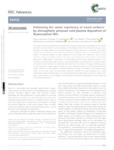Use este identificador para citar ou linkar para este item:
http://www.alice.cnptia.embrapa.br/alice/handle/doc/1070623Registro completo de metadados
| Campo DC | Valor | Idioma |
|---|---|---|
| dc.contributor.author | CADEMARTORI, P. H. G. de | pt_BR |
| dc.contributor.author | STAFFORD, L. | pt_BR |
| dc.contributor.author | BLANCHET, P. | pt_BR |
| dc.contributor.author | MAGALHAES, W. L. E. | pt_BR |
| dc.contributor.author | BOLZON DE MUNIZ, G. I. | pt_BR |
| dc.date.accessioned | 2017-06-08T11:11:11Z | pt_BR |
| dc.date.available | 2017-06-08T11:11:11Z | pt_BR |
| dc.date.created | 2017-06-08 | pt_BR |
| dc.date.issued | 2017 | pt_BR |
| dc.identifier.citation | RSC Advances, v. 7, n. 46, p. 29159-29169, Jun. 2017. | pt_BR |
| dc.identifier.uri | http://www.alice.cnptia.embrapa.br/alice/handle/doc/1070623 | pt_BR |
| dc.description | In this study, fluorocarbon thin filmsweredepositedonthe surfaceofwhite spruce andBrazilian cedarwoods via atmospheric pressure dielectric barrier discharge in the afterglow mode with octafluoropropane gas. A pretreatment with oxygen plasma was introduced before the thin film deposition to determine if this plasma condition could increase the wood nano/micro roughness, helping to improve the hydrophobicity of the surface. The optimal conditions of water repellency for both woods were examined in terms of their resistance to aging in controlled conditions. The water contact angle measurements showed a hydrophobic surface with a stable angle for both woods. X-ray photoelectron spectroscopy reveals the presence of CF, CF2 and CF3 functional groups after the Ar/C3F8 plasma, especially for longer treatments. The open-air system of the plasma reactor leads to the simultaneous fluorination and incorporation of oxygen-containing groups. The pre-treatment of oxygen plasma increases the wood roughness; however, the chemical attachment of oxygen molecules is more significant, negatively affecting the degree of repellency of the plasma-coated woods. On the other hand, the fluorocarbon deposition increases the wood roughness and creates a hydrophobic surface simultaneously. Even with partial defluorination after aging, both plasma-coated woods retain a similar degree of water repellency, which partially avoid chemical reorganization of their surface due to environmental exposure. | pt_BR |
| dc.language.iso | eng | eng |
| dc.rights | openAccess | eng |
| dc.subject | Plasma a frio | pt_BR |
| dc.subject | Filme de fluorcarbono | pt_BR |
| dc.subject | Molhabilidade | pt_BR |
| dc.subject | Plasma atmosférico | pt_BR |
| dc.subject | Superfície hidrofóbica | pt_BR |
| dc.subject | Plasma treatment | pt_BR |
| dc.subject | Surface modification | pt_BR |
| dc.subject | Wetting | pt_BR |
| dc.subject | Atmospheric plasma | pt_BR |
| dc.subject | Hydrophobic surface | pt_BR |
| dc.title | Enhancing the water repellency of wood surfaces by atmospheric pressure cold plasma deposition of fluorocarbon film. | pt_BR |
| dc.type | Artigo de periódico | pt_BR |
| dc.date.updated | 2017-07-11T11:11:11Z | pt_BR |
| dc.subject.thesagro | Madeira | pt_BR |
| dc.subject.nalthesaurus | Wood treatment | pt_BR |
| riaa.ainfo.id | 1070623 | pt_BR |
| riaa.ainfo.lastupdate | 2017-07-11 | pt_BR |
| dc.identifier.doi | 10.1039/c7ra03334f | pt_BR |
| dc.contributor.institution | Pedro Henrique Gonzalez de Cademartori, Doutorando da UFPR; Luc Stafford, Departement de Physique, Universite de Montreal; Pierre Blanchet, NSERC; WASHINGTON LUIZ ESTEVES MAGALHAES, CNPF; Graciela Ines Bolzon de Muniz, UFPR. | pt_BR |
| Aparece nas coleções: | Artigo em periódico indexado (CNPF)  | |
Arquivos associados a este item:
| Arquivo | Descrição | Tamanho | Formato | |
|---|---|---|---|---|
| 2017WashingtonRCSAEnhancing.pdf | 1.42 MB | Adobe PDF |  Visualizar/Abrir |









